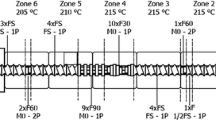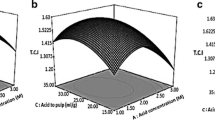Abstract
In this study surface-modified nanofibrillated cellulose (NFC) was used at low levels (0.5 to1.5 wt%) as a reinforcement in a polyvinyl alcohol (PVA) matrix. The modified-NFC–PVA composite films prepared using the solution casting technique showed improved mechanical performance. Birch pulp cellulose was initially modified by allylation using a solvent-free, dry modification method followed by subsequent epoxidation of the allyl groups and finally grinding the pulp to yield epoxy-NFC. In order to obtain optimal mechanical performance, epoxy-NFC with different degrees of substitution was evaluated in the reinforcement of PVA. The addition of 1 wt% epoxy-NFC (degree of substitution, DS 0.07) enhanced the modulus, strength, and strain of pure PVA film by 307, 139 and 23 %, respectively, thus producing the best performing film. The results demonstrate the favourable effect of chemically functionalized NFC on the mechanical properties of polyvinyl alcohol compared to unmodified NFC as reinforcement. In order to improve industrial and economic feasibility, the manufacture of the composite was also done in situ by grinding cellulose directly in PVA to produce the new biocomposite in a one-step process.







Similar content being viewed by others
Abbreviations
- DS:
-
Degree of substitution
- ECF:
-
Elemental chlorine-free
- NFC:
-
Nanofibrillated cellulose
- MFC:
-
Microfibrillated cellulose
- PVOH:
-
Polyvinyl alcohol
- PE:
-
Polyethylene
- PP:
-
Polypropylene
- SEM:
-
Scanning electron microscopy
- FTIR:
-
Fourier transform infrared spectroscopy
- DSC:
-
Differential scanning calorimetry
- CP-MAS:
-
Cross-polarization/magic angle spinning
- 13C NMR:
-
Carbon-13 nuclear magnetic resonance
References
Alexy P, Káchova D, Kršiak M, Bakoš D, Šimkova B (2002) Poly(vinyl alcohol) stabilisation in thermoplastic processing. Polym Degrad Stab 78:413–421
Arola S, Tammelin T, Setälä H, Tullila A, Linder MB (2012) Immobilization stabilization of proteins on nanofibrillated cellulose derivatives and their bioactive film formation. Biomacromolecules 13:594–603
Asikainen S, Fuhrmann A, Robertsen F (2010) Birch pulp fractions for fine paper and board. Nord Pulp Pap Res J 25:269–276
Bai Y, Li Y, Wang M (2006) Study on synthesis of a hydrophilic bead carrier containing epoxy groups and its properties for glucoamylase immobilization. Enzyme Microb Technol 39:540–547
Bhatnagar A, Sain M (2005) Processing of cellulose nanofiber-reinforced composites. J Reinf Plast Compos 24:1259–1268
Bledzki A, Gassan J (1999) Composites reinforced with cellulose based fibres. Prog Polym Sci 24:221–274
Bulota A, Jääskeläinen AS, Paltakari J, Hughes M (2011) Properties of biocomposites: influence of preparation method, testing environment and a comparison with theoretical models. J Mater Sci 46:3387–3398
Burton S, Harding D (1997) Bifunctional etherification of bead cellulose for ligand attachment with allyl bromide and allyl glycidyl ether. J Chromatogr A 775:29–38
Cai X, Riedl B, Ait-Kadi A (2003) Effect of surface-grafted ionic groups on the performance of cellulose-fiber-reinforced thermoplastic composites. J Pol Sci B Polym Phys 41:2022–2032
Chai W-L, Chow J-D, Chen C–C (2012) Effects of modified starch and different molecular weight polyvinyl alcohols on biodegradable characteristics of polyvinyl alcohol/starch blends. J Polym Environ 20:550–564
Dufresne A, Cavaille JY, Vignon MR (1997) Mechanical behaviour of sheets prepared from sugar beet cellulose microfibrils. J Appl Polym Sci 64:1185–1194
Ebeling T, Paillet M, Borsali R, Diat O, Dufresne A, Cavaille JY, Chanzy H (2009) Shear-induced orientation phenomena in suspensions of cellulose microcrystals, revealed by small angle X-ray scattering. Langmuir 15:6123–6126
Eronen P, Österberg M, Heikkinen S, Tenkanen M, Laine J (2011) Interactions of structurally different hemicelluloses with nanofibrillar cellulose. Carbohydr Polym 86:1281–1290
Fakirov S, Bhattacharyya D, Shields RJ (2008) Nanofibril reinforced composites from polymer blends. Colloids Surf A Physicochem Eng Aspects 313–314:2–8
Flieger M, Kantorová M, Prell A, Řezanka T, Votruba J (2003) Biodegradable plastics from renewable sources. Folia Microbiol 48(1):27–44
Fukuzumi H, Saito T, Iwata T, Kumamoto Y, Isogai A (2009) Transparent and high gas barrier films of cellulose nanofibers prepared by TEMPO-mediated oxidation. Biomacromolecules 10:162–165
Guirguis OW, Moselhey MTH (2012) Thermal and structural properties of poly(vinyl alcohol) and hydroxypropyl cellulose blends. Nat Sci 4(1):57–67
Heinze T, Lincke T, Fenn D, Koschella A (2008) Efficient allylation of cellulose in dimethyl sulfoxide/tetrabutylammonium fluoride trihydrate. Polym Bull 61:1–9
Hrabalova M, Schwanninger M, Wimmer R, Gregorova A, Zimmermann T, Mundigler N (2011) Fibrillation of flax and wheat straw cellulose: effects on thermal, morphological, and viscoelastic properties of poly(vinylalcohol)/fibre composites. BioResources 6(2):1631–1647
Hubbe M, Rojas O, Lucia L, Sain M (2008) Cellulosic nanocomposites: a review. BioResources 3:929–980
Huijbrechts A, Haar R, Schols H, Franssen M, Boeriu C, Sudhölter E (2010) Synthesis and application of epoxy starch derivatives. Carbohydr Polym 79:858–866
Jandura P, Kokta B, Riedl B (2000) Fibrous long-chain organic acid cellulose esters and their characterization by diffuse reflectance FTIR spectroscopy, solid state CP/MAS 13C-NMR, and X-ray diffraction. J Appl Polym Sci 78:1354–1365
Jipa IM, Dobre L, Stroescu M, Stoica-Guzun A, Jinga S, Dobre T (2012) Preparation and characterization of bacterial cellulose-poly (vinyl alcohol) films with antimicrobial properties. Mater Lett 66:125–127
Jonoobi M, Harun J, Mathew AP, Oksman K (2010) Mechanical properties of cellulose nanofiber (CNF) reinforced polylactic acid (PLA) prepared by twin screw extrusion. Compos Sci Technol 70:1742–1747
Kangas H, Lahtinen P, Sneck A, Saariaho A-M, Laitinen O, Hellen E (2014) Characterization of fibrillated celluloses. A short review and evaluation of characteristics with a combination of methods. Nordic Pulp Pap Res J 29:129–143
Kavaliauskaite R, Klimaviciute R, Zemaitaitis A (2008) Factors influencing production of cationic starches. Carbohydr Polym 73:665–675
Leitner J, Hinterstoisser B, Wastyn M, Keckes J, Gindl W (2007) Sugar beet cellulose nanofibril-reinforced composites. Cellulose 14:419–425
Li W, Zhao X, Huang Z, Liu S (2013) Nanocellulose fibrils isolated from BHKP using ultrasonication and their reinforcing properties in transparent poly(vinyl alcohol) films. J Polym Res 20(8):1–7
Lin MS, Huang CS (1992) Syntheses and characterizations of allyl cellulose and glycidyl cellulose. J Polym Sci Part A Polym Chem 30(11):2303–2312
Liu D, Sun X, Tian H, Maiti S, Ma Z (2013) Effects of cellulose nanofibrils on the structure and properties on PVA nanocomposites. Cellulose 20:2981–2989
Lu J, Wang T, Drzal LT (2008) Preparation and properties of microfibrillated cellulose polyvinyl alcohol composite materials. Compos A 39:738–746
Mu-Shih L, Chung-Song H (1992) Syntheses and characterizations of allyl cellulose and glycidyl cellulose. J Polym Sci A 30:2303–2312
Nakagaito AN, Yano H (2008) The effect of fiber content on the mechanical and thermal expansion properties of biocomposites based on microfibrillated cellulose. Cellulose 15:555–559
Nakagaito AN, Fujimura A, Sakai T, Hama Y, Yano H (2009) Production of microfibrillated cellulose (MFC)-reinforced polylactic acid (PLA) nanocomposites from sheets obtained by a papermaking-like process. Comp Sci Technol 69:1293–1297
Nichifor M, Stanciu M, Simionescu B (2010) New cationic hydrophilic and amphiphilic polysaccharides synthesized by one pot procedure. Carbohydr Polym 82:965–975
Nishimura M, Donkai N, Miyamoto T (1997) Preparation and properties of a new type of comb-shaped, amphiphilic cellulose derivative. Cellulose 4:89–98
Peresin MS, Habibi Y, Zoppe JO, Pawlak JJ, Rojas OJ (2010) Nanofiber composites of polyvinyl alcohol and cellulose nanocrystals: manufacture and characterization. Biomacromolecules 11:674–681
Shang Y, Peng Y (2007) Research of a PVA composite ultrafiltration membrane used in oil-in-water. Desalination 204:322–327
Shiramizu K, Shiga N, Magara T, Oguni K, Lin L (2012) Cellulose nanofibers, method for producing same, composite resin composition and molded body. US Patent 2012/0328877 A1
Siqueira G, Bras J, Dufresne A (2010) Cellulosic bionanocomposites: a review of preparation, properties and applications. Polymers 2:728–765
Spinu M, Dos Santos N, Le Moigne N, Navard P (2011) How does the never-dried state influence the swelling and dissolution of cellulose fibres in aqueous solvent? Cellulose 18:247–256
Srithep Y, Turng L-S, Sabo R, Clemons C (2012) Nanofibrillated cellulose (NFC) reinforced polyvinylalcohol (PVOH) nanocomposites: properties, solubility of carbon dioxide, and foaming. Cellulose 19:1209–1223
Stenstad P, Andresen M, Tanem BS, Stenius P (2008) Chemical surface modifications of microfibrillated cellulose. Cellulose 15:35–45
Tang C, Liu H (2008) Cellulose reinforced poly (vinyl alcohol) composite film with high visible light transmittance. Compos A 39:1638–1643
Tezuka Y, Tsuchiya Y, Shiomi T (1996) 13C NMR determination of substituent distribution in carboxymethylcellulose by use of its pre-esterified derivatives. Carbohydr Res 291:99–108
Tomasik P, Schilling C (2004) Chemical modification of starch. Adv Carbohydr Chem Biochem 59:175–403
Virtanen S, Vartiainen J, Setälä H, Tammelin T, Vuoti S (2014) Modified nanofibrillated cellulose-polyvinyl alcohol films with improved mechanical performance. RSC Adv 4:11343–11350
Vuoti S, Talja R, Johansson L-S, Heikkinen H, Tammelin T (2013) Solvent impact on esterification and film formation ability of nanofibrillated cellulose. Cellulose 20:2359–2370
Wan WK, Hutter JL, Millon LE, Guhados G (2006) Bacterial cellulose and its nanocomposites for biomedical applications. In: Oksman K, Sain M (eds) Cellulose nanocomposites. Processing, characterization, and properties. American Chemical Society, Washington DC
Wang B, Sain M (2007) Dispersion of soybean stock-based nanofiber in a plastic matrix. Polym Int 56:538–546
White J, Beck L, Ferguson D, Haw J (1992) Background suppression in MAS–NMR. J Magn Res 100:336–341
Wu J, Yu D, Chan C-M, Kim J, Mai Y-W (2000) Effect of fiber pretreatment condition on the interfacial strength and mechanical properties of wood fiber/PP composites. J Appl Polym Sci 76:1000–1010
Zhang W, Yang X, Li C, Liang M, Lu C, Deng Y (2011) Mechanochemical activation of cellulose and its thermoplastic polyvinyl alcohol ecocomposites with enhanced physicochemical properties. Carbohydr Polym 83:257–263
Zimmerman T, Pöhler E, Geiger T (2004) Cellulose fibrils for polymer reinforcement. Adv Eng Mater 6:754–761
Acknowledgments
The Finnish Funding Agency for Technology and Innovation, Tekes, and companies within the Naseva II project are deeply acknowledged for their financial support. We would also like to thank UPM-Kymmene Oy for supplying the cellulose material. Finally, we would like to acknowledge Seppo Kuosmanen, Minna Kalliosaari, Marketta Hiltunen, and Eija Silvasti for their excellent laboratory assistance.
Author information
Authors and Affiliations
Corresponding author
Rights and permissions
About this article
Cite this article
Virtanen, S., Vuoti, S., Heikkinen, H. et al. High strength modified nanofibrillated cellulose-polyvinyl alcohol films. Cellulose 21, 3561–3571 (2014). https://doi.org/10.1007/s10570-014-0347-7
Received:
Accepted:
Published:
Issue Date:
DOI: https://doi.org/10.1007/s10570-014-0347-7




